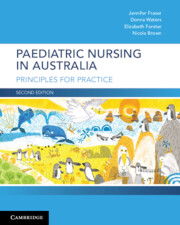34 results
Index
-
- Book:
- Paediatric Nursing in Australia and New Zealand
- Published online:
- 05 January 2022
- Print publication:
- 05 January 2022, pp 373-382
-
- Chapter
- Export citation
Acronyms and abbreviations
-
- Book:
- Paediatric Nursing in Australia and New Zealand
- Published online:
- 05 January 2022
- Print publication:
- 05 January 2022, pp xv-xviii
-
- Chapter
- Export citation
Contributors
-
- Book:
- Paediatric Nursing in Australia and New Zealand
- Published online:
- 05 January 2022
- Print publication:
- 05 January 2022, pp x-xii
-
- Chapter
- Export citation

Paediatric Nursing in Australia and New Zealand
-
- Published online:
- 05 January 2022
- Print publication:
- 05 January 2022
-
- Textbook
- Export citation
Contents
-
- Book:
- Paediatric Nursing in Australia and New Zealand
- Published online:
- 05 January 2022
- Print publication:
- 05 January 2022, pp v-ix
-
- Chapter
- Export citation
Acknowledgement of Country
-
- Book:
- Paediatric Nursing in Australia and New Zealand
- Published online:
- 05 January 2022
- Print publication:
- 05 January 2022, pp i-ii
-
- Chapter
- Export citation
Part A - Contexts of nursing care
-
- Book:
- Paediatric Nursing in Australia and New Zealand
- Published online:
- 05 January 2022
- Print publication:
- 05 January 2022, pp 1-112
-
- Chapter
- Export citation
Copyright page
-
- Book:
- Paediatric Nursing in Australia and New Zealand
- Published online:
- 05 January 2022
- Print publication:
- 05 January 2022, pp iv-iv
-
- Chapter
- Export citation
Preface
-
- Book:
- Paediatric Nursing in Australia and New Zealand
- Published online:
- 05 January 2022
- Print publication:
- 05 January 2022, pp xiii-xiii
-
- Chapter
- Export citation
Part C - Nursing children and young people
-
- Book:
- Paediatric Nursing in Australia and New Zealand
- Published online:
- 05 January 2022
- Print publication:
- 05 January 2022, pp 163-372
-
- Chapter
- Export citation
Acknowledgements
-
- Book:
- Paediatric Nursing in Australia and New Zealand
- Published online:
- 05 January 2022
- Print publication:
- 05 January 2022, pp xiv-xiv
-
- Chapter
- Export citation
Part B - Nursing infants, young children and their families
-
- Book:
- Paediatric Nursing in Australia and New Zealand
- Published online:
- 05 January 2022
- Print publication:
- 05 January 2022, pp 113-162
-
- Chapter
- Export citation
Risk of suicide in patients who present to hospital after self-cutting according to site of injury: findings from the Multicentre Study of Self-harm in England
-
- Journal:
- Psychological Medicine / Volume 53 / Issue 4 / March 2023
- Published online by Cambridge University Press:
- 04 August 2021, pp. 1400-1408
-
- Article
- Export citation
Naloxone dosing in the era of ultra-potent opioid overdoses: a systematic review
-
- Journal:
- Canadian Journal of Emergency Medicine / Volume 22 / Issue 2 / March 2020
- Published online by Cambridge University Press:
- 20 January 2020, pp. 178-186
- Print publication:
- March 2020
-
- Article
-
- You have access
- HTML
- Export citation
Contents
-
- Book:
- Paediatric Nursing in Australia
- Published online:
- 21 June 2018
- Print publication:
- 18 May 2017, pp v-ix
-
- Chapter
- Export citation

Paediatric Nursing in Australia
- Principles for Practice
-
- Published online:
- 21 June 2018
- Print publication:
- 18 May 2017
-
- Book
- Export citation
List of contributors
-
- Book:
- Paediatric Nursing in Australia
- Published online:
- 21 June 2018
- Print publication:
- 18 May 2017, pp x-x
-
- Chapter
- Export citation
Index
-
- Book:
- Paediatric Nursing in Australia
- Published online:
- 21 June 2018
- Print publication:
- 18 May 2017, pp 254-259
-
- Chapter
- Export citation
Preface
-
-
- Book:
- Paediatric Nursing in Australia
- Published online:
- 21 June 2018
- Print publication:
- 18 May 2017, pp xi-xii
-
- Chapter
- Export citation
Frontmatter
-
- Book:
- Paediatric Nursing in Australia
- Published online:
- 21 June 2018
- Print publication:
- 18 May 2017, pp i-iv
-
- Chapter
- Export citation

